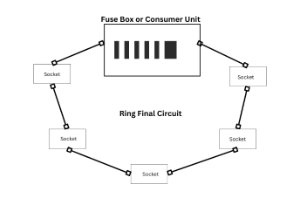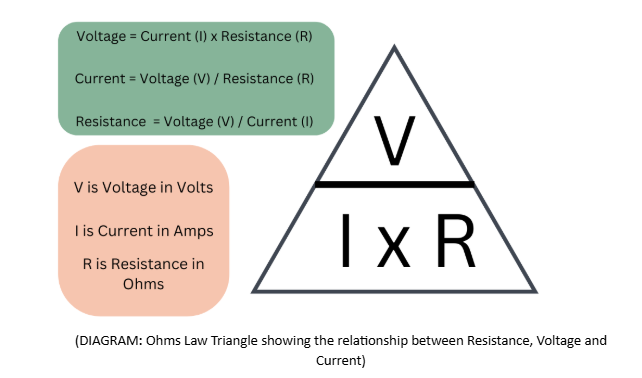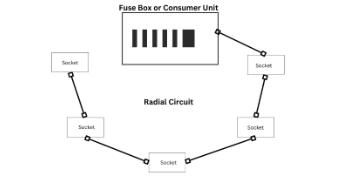A guide to UK Electrical Terminology and Jargon - Electrical Faults Fixed
Understanding electrical terminology is essential for anyone involved in the electrical trade, home improvement projects, or simply trying to make sense of technical reports. This guide serves as a comprehensive resource for UK-specific electrical jargon, ensuring clarity for professionals, students, and curious homeowners alike.
Table of Contents
- Basics of Electrical Circuits and Current
- Distribution Boards, Consumer Units and Safety Devices
- Wiring and Regulations
- Components and Accessories
- Understanding Voltage, Resistance, and Power
- Safety Measures and Protective Devices
- Common Electrical Problems
- Key UK-Specific Terminology
- Final Tips for Homeowners and Enthusiasts
- Glossary of Electrical Terms
1) Basics of Electrical Circuits and Current
An electrical circuit is a pathway through which electricity flows. The primary components include:
- Power Source: Such as a battery or mains electricity.
- Conductors: Typically, copper wires allowing the flow of electricity
- Load: Devices or appliances consuming electrical energy, like a light bulb or heating element.
- Line Conductor and Load Conductor
Electrical current is the flow of electric charge through a conductor, measured in amperes (amps). Current can be categorised as:
- Alternating Current (AC): Found in mains electricity, where current direction alternates many times each second at the frequency it is generated (50Hz UK, 60Hz U.S)
- Direct Current (DC): Found in batteries, where current flows in one direction.
2) Distribution Boards, Consumer Units and Safety Devices
In UK homes, electrical supply is distributed through a consumer unit, also called a fuse box. Key components include:
- Main Switch: Allows the entire electrical supply to be turned off in emergencies.
- Miniature Circuit Breakers (MCBs): Protect circuits from overload by interrupting the flow of electricity.
- Residual Current Devices (RCDs): Detect imbalances in current flow, preventing electric shocks.
- Circuit Protective Conductor (Earth Wire): Prevents exposed metal parts from becoming live.
Ring final circuits, also known as ring mains, are a common wiring method in UK properties. These electric circuits form a loop, starting and ending at the distribution board / consumer unit. This design allows smaller cables to be used while maintaining safety. These are used on socket outlet (plug socket) circuits as below.

(DIAGRAM: Ring Final Socket Outlet Circuit)
Back to top3) Wiring and Regulations
Electrical wiring in the UK must adhere to British Standard BS 7671 and Part P of the Building Regulations to ensure safety. Key terms include:
- Line Conductor: The wire carrying voltage from the power source. The line conductor is a LIVE conductor.
- Neutral Conductor: Returns current to the source, completing the circuit. The neutral conductor is a LIVE conductor.
- Earth Fault: A safety issue caused by a live conductor coming into contact with earthed components.
4) Components and Accessories
Common electrical accessories found in UK installations include:
- Light Fittings: Fixtures holding bulbs, often wired to a switch.
- Fused Connection Units: Used to connect appliances directly to the mains supply via a fuse in the load conductor to protect the wiring where its cross sectional area reduces to supply the appliance.
- Socket Outlets: Points for plugging in appliances, available in regular or switched versions.
For specialist installations, you may encounter extra low voltage systems, used in applications like LED lighting or security systems, where voltage levels are below 50V AC.
Back to top5) Understanding Voltage, Resistance, and Power
- Voltage: Also referred to as electrical pressure or electromotive force (EMF), is the potential difference between two points in a circuit, measured in volts (V).
- Electrical Resistance: Opposes and restricts the current flow, measured in ohms (Ω).
- Electrical Power: The rate of energy use or transfer, measured in watts (W). Calculated using the formula: P=V×IP = V \times IP=V×I (Power = Voltage × Current).

(DIAGRAM: Ohms Law Triangle showing the relationship between Resistance, Voltage and Current)
Back to top6) Safety Measures and Protective Devices
Safety is paramount in any electrical work. Key measures include:
- Using circuit protection devices like RCDs, MCBs, or fuses to prevent overload and short circuits. Overcurrent protection devices and Earth Fault Protection Devices are different.
- Regular periodic inspection reports (EICRs) to identify potential hazards.
- Ensuring all installations comply with international standards and UK-specific wiring regulations.
A ground fault circuit interrupter (GFCI) is another vital safety device, similar to an RCD, offering protection against ground faults. GFCI devices are used in the USA and Canada and operate much like an RCD safety device.
Back to top7) Common Electrical Problems
Some frequent issues include:
- Short Circuits: Caused by unintended contact between live and neutral wires, resulting in high current flow. See Short Circuit
- Voltage Drops: Reduction in voltage between the power supply and the load, often caused by long cables, undersized conductors and large electrical demand on a circuit.
- Power Surges: Sudden spikes in voltage, which can damage electrical devices and equipment.
There are many electrical problems that can occur in the home, see our article here.
Back to top8) Key UK-Specific Terminology
To ensure accuracy and compliance in UK-based projects, familiarize yourself with these terms:
- Consumer Control Unit (CCU): Another term for a fuse box or distribution board.
- Ring Main: A UK-specific wiring system. Correct term is Ring Final Circuit.
- Periodic Inspection Report: Now referred to as an EICR, used for assessing existing installations.
- Steel Wire Armoured (SWA) Cable: Commonly used for underground installations.
9) Final Tips for Homeowners and Enthusiasts
If you’re tackling domestic electrical installations, always:
- Consult a qualified electrician for complex tasks.
- Use materials that meet British Standards.
- Schedule inspections at regular intervals to maintain safety.
10) Glossary of Electrical Terms
AC (Alternating Current): An electric current that reverses its direction periodically, commonly used in mains electricity.
Ampere (Amp): The unit of measurement for electric current, representing the flow of one coulomb per second.
Bonding: Equipotential bonding that connects extraneous conductive parts of an installation to the MET.
Capacitance: The ability of a system to store an electric charge, measured in farads (F).
Charge (Electric Charge): A property of matter that causes it to experience a force in an electric field, measured in coulombs (C).
Circuit Protection Device: A device such as a fuse or circuit breaker designed to protect circuits from overcurrent conditions.
Consumer Unit – The brains of the electrical system containing earth fault protection device, overcurrent protection devices and other components. Commonly referred to as consumer unit, fuse box and fuse board in domestic installations or distribution board in commercial and industrial installations.
CPC (Circuit Protective Conductor): The conductor used to connect exposed conductive parts to the main earthing terminal.
Current (Electrical Current): The flow of electric charge in a circuit, measured in amperes.
DC (Direct Current): An electric current flowing in one direction only, commonly found in batteries and electronic circuit boards.
Distribution Board: A panel that houses fuses or circuit breakers for various circuits, also known as a consumer unit. Also see consumer unit and fuse box
E.M.F. (Electromotive Force): The energy provided by a power source per coulomb of charge, measured in volts.
Earthing Conductor – The protective conductor that connects the Main Earthing Terminal to the means of earthing for the installation.
Earth Fault: A fault where a live conductor makes contact with a earthed part, posing a safety risk. Can also occur where insulation resistance in the circuit falls below an acceptable threshold causing earth leakage current.
Earth Leakage Current – Electrical current that has left the electrical circuit and is flowing in the protective conductor.
Earth Wire: A safety wire that prevents exposed metal parts from becoming live for a significant duration.
EIC (Electrical Installation Certificate): A certificate issued after the completion of new electrical work, confirming compliance with safety standards. Such instances would be new circuits, rewires and consumer unit replacements.
EICR (Electrical Installation Condition Report): A report assessing the suitability of an installation for continued use. EICR reports should be compared against current wiring regulations.
Equipotential Bonding: Connecting exposed conductive parts together to maintain the same electrical potential as extraneous conductive parts thereby reducing electrical shock risk.
Extra Low Voltage (ELV): Voltage not exceeding 50V AC or 120V DC, commonly used in lighting and control systems.
Farad: The unit of capacitance, representing one coulomb of charge per volt.
Final Circuit: A circuit that directly supplies electrical appliances or sockets.
Fuse: A safety device that melts and breaks the circuit when excessive current flows.
Fuse Box: An older style “consumer unit” containing fuses or fuse wire as opposed to circuit breakers or other types of trip switches.
GFCI (Ground Fault Circuit Interrupter): A device that disconnects the circuit when it detects ground faults.
Insulation Resistance: The resistance offered by insulating material to prevent current leakage.
International Standards: Standards recognized globally for electrical safety and performance, such as IEC standards.
IP Rating: Ingress Protection rating, indicating the level of protection against dust and water ingress.
Joule: A unit of energy, representing one watt of power expended for one second.
Live Conductor: A conductor that carries current under normal conditions.
Magnetic Field: The area around a magnet or current-carrying conductor where magnetic forces can be observed.
Main Switch: A switch in the consumer unit that controls the electrical supply to the entire property. Also referred to as a Linked Main Switch.
Miniature Circuit Breaker (MCB): A device that automatically switches off the circuit during overload or short circuits.
Neutral Conductor: A conductor that completes the circuit by carrying current back to the source.
Ohm (Ω): The unit of electrical resistance.
Ohm’s Law: A principle stating that the current through a conductor is directly proportional to voltage and inversely proportional to resistance.
Overcurrent: A condition where electrical current exceeds the rated capacity of a circuit.
Partial Rewire: Replacing only specific circuits or sections of an electrical installation.
Periodic Inspection Report (PIR): A former term for the EICR (Electrical Installation Condition Report)
Potential Difference: The energy difference per unit charge between two points in a circuit, measured in volts.
Power (Electrical Power): The rate at which electrical energy is used or transferred, measured in watts.
Power Surge: A sudden increase in voltage, which can damage electrical equipment.
Protective Bonding Conductor: (see. Equipotential Bonding and Supplementary Bonding.) A conductor that connects non-electrical parts to prevent a dangerous potential difference.
Protective Devices: Devices such as fuses, RCDs, and MCBs used to ensure electrical safety.
Radial Circuit – A circuit that begins at the origin (Db or Consumer Unit) and has a definitive end whilst feeding outlets or electrical loads along its path.

(Diagram: Radial Socket Outlet Circuit)
Resistance: Opposition to the flow of electric current, measured in ohms.
Resistivity: A material property defining how strongly it opposes current flow, expressed in ohm-metres.
Residual Current Device (RCD): A safety device that disconnects a circuit when it detects an imbalance in current flow.
Ring Circuit: A UK-specific wiring configuration that loops back to the consumer unit.
Safety Device: Equipment designed to protect people or installations from electrical hazards.
Safety Measure: Any action or device implemented to ensure electrical safety.
Short Circuit: A fault condition where live and neutral conductors make direct contact, causing high current flow.
Solid-State Device: A device with no moving parts, such as transistors or diodes.
Specific Section of the Building Regulations: Refers to Part P, governing electrical safety in dwellings.
Supplementary Equipotential Bonding: Additional bonding in areas with increased risk of electric shock, such as bathrooms.
Twin and Earth: Industry recognised unofficial term for 6242y cable. The cable incorporates a Line and Neutral conductor with integral CPC. The CPC can either be pre-sleeved or without earth sleeving.
Unit of Measurement: A standard quantity used to measure electrical parameters, such as volts, amps, or ohms.
Voltage: The electrical potential difference, also referred to as electrical pressure.
Voltage Drop: The reduction in voltage across a circuit due to resistance.
Watt (W): The unit of electrical power.
Wiring Regulations: Standards set by BS 7671 in the UK, governing the design, installation, and verification of electrical systems.
Ze: The external earth fault loop impedance measured at the origin of an installation.
Zs: The total earth fault loop impedance for a circuit, including the supply, line, and circuit protective conductors.
Back to top
Read more articles
- Log in to post comments


